Financial Decision Making Report: Divisionalisation, Working Capital
VerifiedAdded on 2023/01/09
|11
|2533
|77
Report
AI Summary
This report provides a comprehensive analysis of financial decision-making for GoGo Airline, addressing the parent company's plan to divide its airline business. It begins with a critical evaluation of the advantages and disadvantages of divisionalisation, considering its impact on operational autonomy, specialization, and cost. The report then details various performance measurement techniques, including Return on Investment (ROI), Residual Income (RI), and Economic Value Added (EVA) for proposed divisions, and performance appraisal methods for divisional managers. The importance of non-financial measures, such as customer loyalty and intellectual capital, is highlighted, alongside their role in long-term strategic alignment. Furthermore, the report outlines the costs associated with different elements of working capital (cash, receivables, inventory, and payables) and presents methods for controlling these elements, such as maintaining adequate liquidity, managing credit policies, optimizing inventory levels, and controlling disbursement floats. The report concludes by summarizing key findings and recommendations for GoGo Airline's financial strategy, emphasizing the need to balance divisionalisation benefits with effective performance measurement and working capital management.

Running head: FINANCIAL DECISION MAKING
Financial Decision Making
Name of the Student
Name of the University
Author’s Note
Financial Decision Making
Name of the Student
Name of the University
Author’s Note
Paraphrase This Document
Need a fresh take? Get an instant paraphrase of this document with our AI Paraphraser
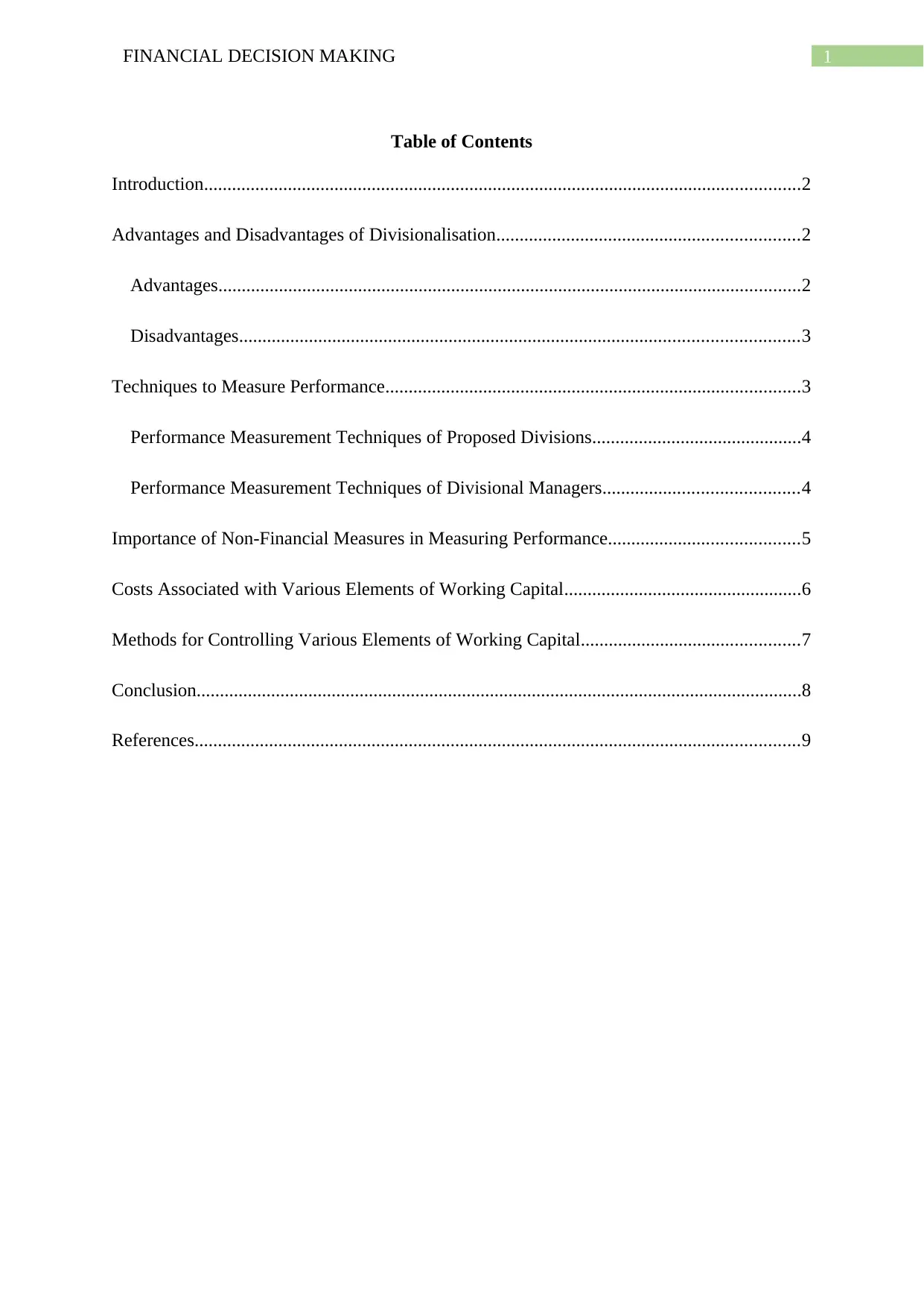
1FINANCIAL DECISION MAKING
Table of Contents
Introduction................................................................................................................................2
Advantages and Disadvantages of Divisionalisation.................................................................2
Advantages.............................................................................................................................2
Disadvantages........................................................................................................................3
Techniques to Measure Performance.........................................................................................3
Performance Measurement Techniques of Proposed Divisions.............................................4
Performance Measurement Techniques of Divisional Managers..........................................4
Importance of Non-Financial Measures in Measuring Performance.........................................5
Costs Associated with Various Elements of Working Capital...................................................6
Methods for Controlling Various Elements of Working Capital...............................................7
Conclusion..................................................................................................................................8
References..................................................................................................................................9
Table of Contents
Introduction................................................................................................................................2
Advantages and Disadvantages of Divisionalisation.................................................................2
Advantages.............................................................................................................................2
Disadvantages........................................................................................................................3
Techniques to Measure Performance.........................................................................................3
Performance Measurement Techniques of Proposed Divisions.............................................4
Performance Measurement Techniques of Divisional Managers..........................................4
Importance of Non-Financial Measures in Measuring Performance.........................................5
Costs Associated with Various Elements of Working Capital...................................................6
Methods for Controlling Various Elements of Working Capital...............................................7
Conclusion..................................................................................................................................8
References..................................................................................................................................9
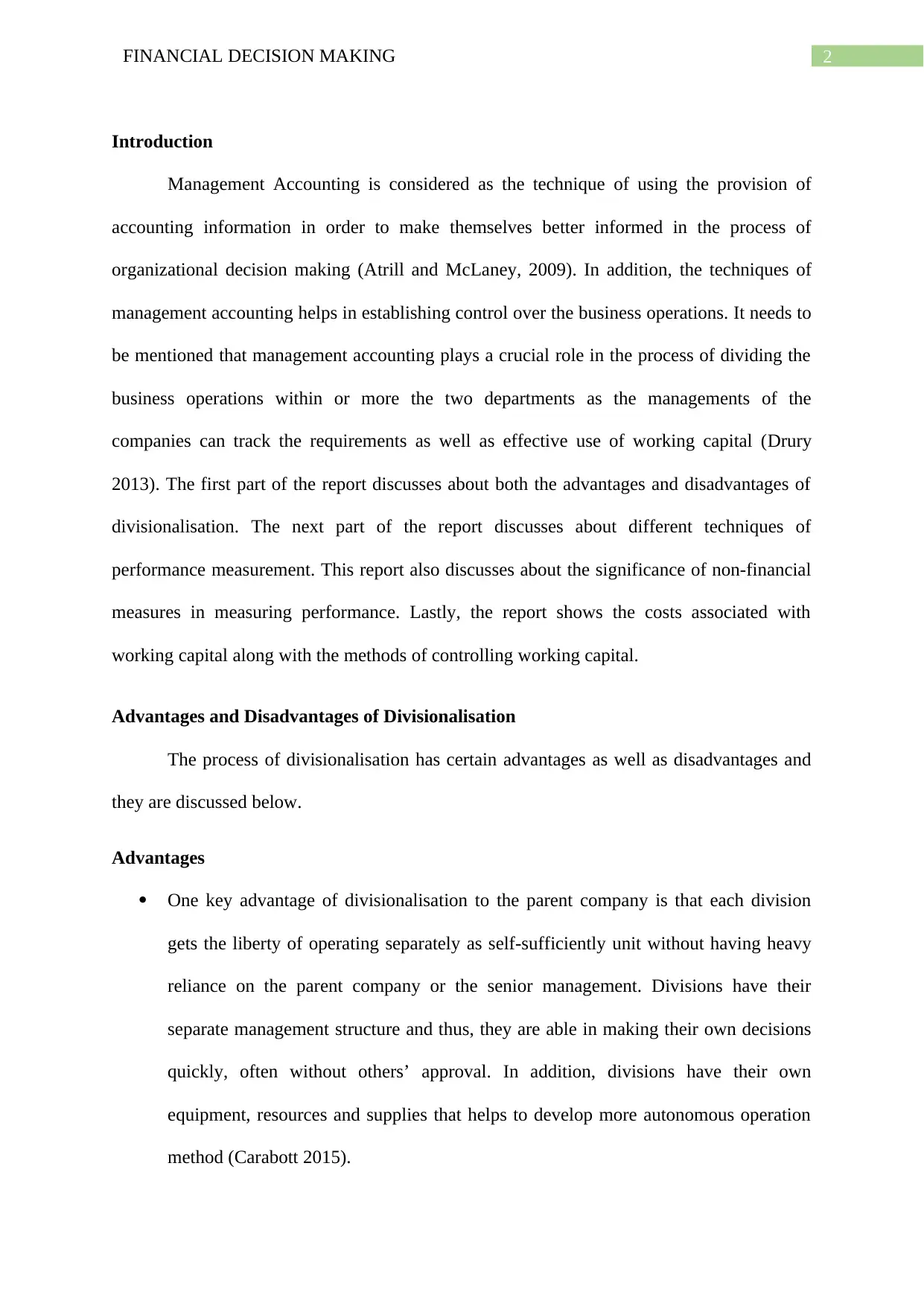
2FINANCIAL DECISION MAKING
Introduction
Management Accounting is considered as the technique of using the provision of
accounting information in order to make themselves better informed in the process of
organizational decision making (Atrill and McLaney, 2009). In addition, the techniques of
management accounting helps in establishing control over the business operations. It needs to
be mentioned that management accounting plays a crucial role in the process of dividing the
business operations within or more the two departments as the managements of the
companies can track the requirements as well as effective use of working capital (Drury
2013). The first part of the report discusses about both the advantages and disadvantages of
divisionalisation. The next part of the report discusses about different techniques of
performance measurement. This report also discusses about the significance of non-financial
measures in measuring performance. Lastly, the report shows the costs associated with
working capital along with the methods of controlling working capital.
Advantages and Disadvantages of Divisionalisation
The process of divisionalisation has certain advantages as well as disadvantages and
they are discussed below.
Advantages
One key advantage of divisionalisation to the parent company is that each division
gets the liberty of operating separately as self-sufficiently unit without having heavy
reliance on the parent company or the senior management. Divisions have their
separate management structure and thus, they are able in making their own decisions
quickly, often without others’ approval. In addition, divisions have their own
equipment, resources and supplies that helps to develop more autonomous operation
method (Carabott 2015).
Introduction
Management Accounting is considered as the technique of using the provision of
accounting information in order to make themselves better informed in the process of
organizational decision making (Atrill and McLaney, 2009). In addition, the techniques of
management accounting helps in establishing control over the business operations. It needs to
be mentioned that management accounting plays a crucial role in the process of dividing the
business operations within or more the two departments as the managements of the
companies can track the requirements as well as effective use of working capital (Drury
2013). The first part of the report discusses about both the advantages and disadvantages of
divisionalisation. The next part of the report discusses about different techniques of
performance measurement. This report also discusses about the significance of non-financial
measures in measuring performance. Lastly, the report shows the costs associated with
working capital along with the methods of controlling working capital.
Advantages and Disadvantages of Divisionalisation
The process of divisionalisation has certain advantages as well as disadvantages and
they are discussed below.
Advantages
One key advantage of divisionalisation to the parent company is that each division
gets the liberty of operating separately as self-sufficiently unit without having heavy
reliance on the parent company or the senior management. Divisions have their
separate management structure and thus, they are able in making their own decisions
quickly, often without others’ approval. In addition, divisions have their own
equipment, resources and supplies that helps to develop more autonomous operation
method (Carabott 2015).
⊘ This is a preview!⊘
Do you want full access?
Subscribe today to unlock all pages.

Trusted by 1+ million students worldwide

3FINANCIAL DECISION MAKING
Another major structure of divisionalisation is that it provides the scope for high
degree of specialization. In divisions, employees with similar abilities and talents get
the chance to work together so that they can focus on special projects for meeting the
divisional objectives. Since, autonomous operations can be seen in the divisions, their
managements are most likely to be familiar with the employee and thus, they can
ensure the presence of the needed resources to complete their tasks. These aspects
reduce pressure from the parent companies (Kumar 2015).
Disadvantages
It needs to be mentioned that divisionalisation results in too great sense of autonomy
among the divisions. Thus, each division may consider itself as a completely separate
from the other divisions and they become worried about meeting their own objectives
and goals instead of the objectives and goals of the parent company as a whole. In
case there is ineffective leadership within the parent company, this can lead to the
failure in the organizations at peak efficiency level that can results in failure in
achieving the objectives (Cowling 2013).
Another major disadvantage of divisionalisation is that it can be more expensive to
operate. Each division requires their own resources since they operate separately and
thus, the concept of sharing resources may not be practical for these divisions. This
can also lead to the duplication of resources. For this reason, the parent companies are
needed to ensure the equal allocation of resources within the divisions for getting rid
of this disadvantage (Cowling 2013).
Techniques to Measure Performance
Certain techniques are used for measuring the performance of the proposed divisions
and their managers on GoGo Airline and they are discussed below.
Another major structure of divisionalisation is that it provides the scope for high
degree of specialization. In divisions, employees with similar abilities and talents get
the chance to work together so that they can focus on special projects for meeting the
divisional objectives. Since, autonomous operations can be seen in the divisions, their
managements are most likely to be familiar with the employee and thus, they can
ensure the presence of the needed resources to complete their tasks. These aspects
reduce pressure from the parent companies (Kumar 2015).
Disadvantages
It needs to be mentioned that divisionalisation results in too great sense of autonomy
among the divisions. Thus, each division may consider itself as a completely separate
from the other divisions and they become worried about meeting their own objectives
and goals instead of the objectives and goals of the parent company as a whole. In
case there is ineffective leadership within the parent company, this can lead to the
failure in the organizations at peak efficiency level that can results in failure in
achieving the objectives (Cowling 2013).
Another major disadvantage of divisionalisation is that it can be more expensive to
operate. Each division requires their own resources since they operate separately and
thus, the concept of sharing resources may not be practical for these divisions. This
can also lead to the duplication of resources. For this reason, the parent companies are
needed to ensure the equal allocation of resources within the divisions for getting rid
of this disadvantage (Cowling 2013).
Techniques to Measure Performance
Certain techniques are used for measuring the performance of the proposed divisions
and their managers on GoGo Airline and they are discussed below.
Paraphrase This Document
Need a fresh take? Get an instant paraphrase of this document with our AI Paraphraser
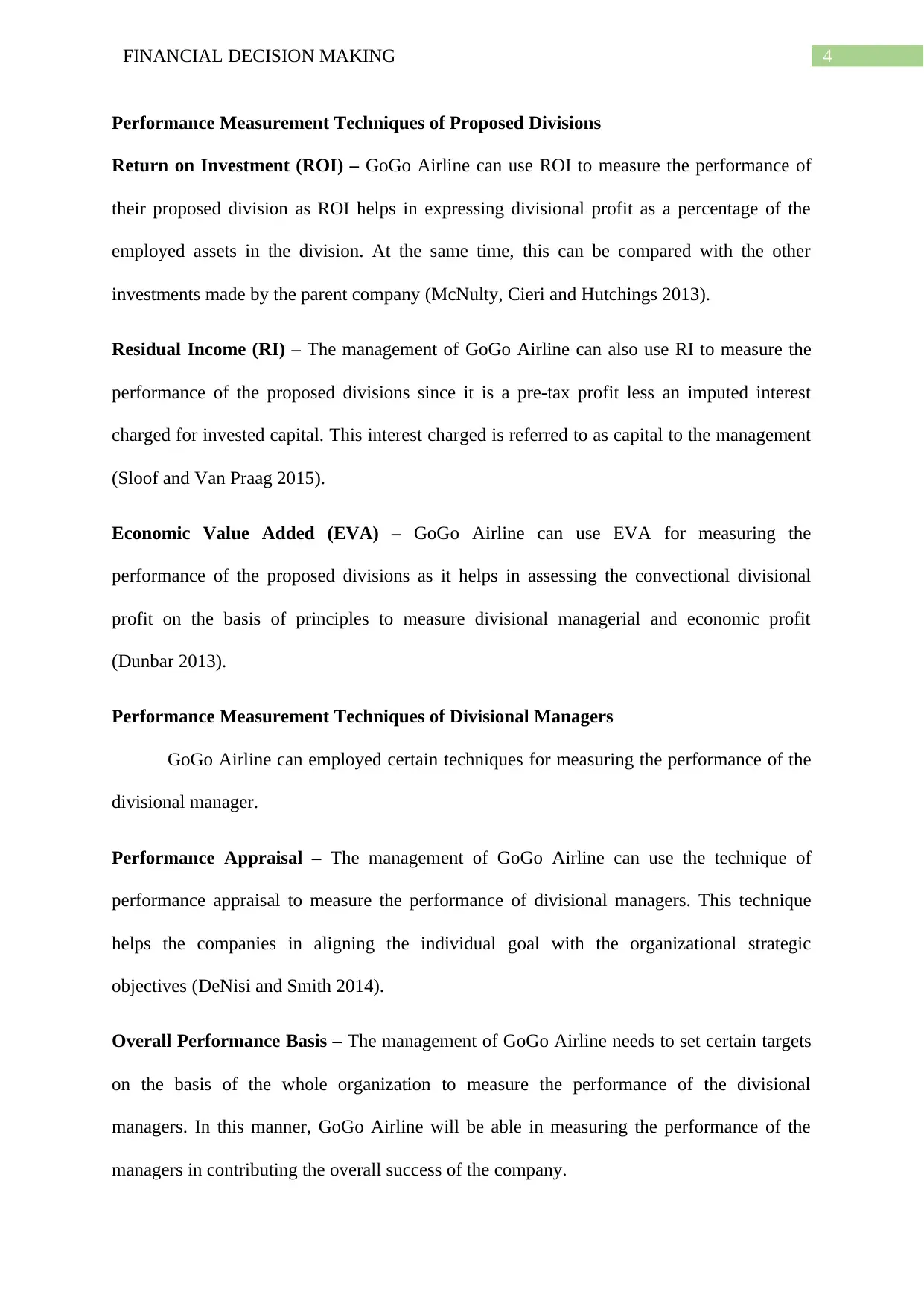
4FINANCIAL DECISION MAKING
Performance Measurement Techniques of Proposed Divisions
Return on Investment (ROI) – GoGo Airline can use ROI to measure the performance of
their proposed division as ROI helps in expressing divisional profit as a percentage of the
employed assets in the division. At the same time, this can be compared with the other
investments made by the parent company (McNulty, Cieri and Hutchings 2013).
Residual Income (RI) – The management of GoGo Airline can also use RI to measure the
performance of the proposed divisions since it is a pre-tax profit less an imputed interest
charged for invested capital. This interest charged is referred to as capital to the management
(Sloof and Van Praag 2015).
Economic Value Added (EVA) – GoGo Airline can use EVA for measuring the
performance of the proposed divisions as it helps in assessing the convectional divisional
profit on the basis of principles to measure divisional managerial and economic profit
(Dunbar 2013).
Performance Measurement Techniques of Divisional Managers
GoGo Airline can employed certain techniques for measuring the performance of the
divisional manager.
Performance Appraisal – The management of GoGo Airline can use the technique of
performance appraisal to measure the performance of divisional managers. This technique
helps the companies in aligning the individual goal with the organizational strategic
objectives (DeNisi and Smith 2014).
Overall Performance Basis – The management of GoGo Airline needs to set certain targets
on the basis of the whole organization to measure the performance of the divisional
managers. In this manner, GoGo Airline will be able in measuring the performance of the
managers in contributing the overall success of the company.
Performance Measurement Techniques of Proposed Divisions
Return on Investment (ROI) – GoGo Airline can use ROI to measure the performance of
their proposed division as ROI helps in expressing divisional profit as a percentage of the
employed assets in the division. At the same time, this can be compared with the other
investments made by the parent company (McNulty, Cieri and Hutchings 2013).
Residual Income (RI) – The management of GoGo Airline can also use RI to measure the
performance of the proposed divisions since it is a pre-tax profit less an imputed interest
charged for invested capital. This interest charged is referred to as capital to the management
(Sloof and Van Praag 2015).
Economic Value Added (EVA) – GoGo Airline can use EVA for measuring the
performance of the proposed divisions as it helps in assessing the convectional divisional
profit on the basis of principles to measure divisional managerial and economic profit
(Dunbar 2013).
Performance Measurement Techniques of Divisional Managers
GoGo Airline can employed certain techniques for measuring the performance of the
divisional manager.
Performance Appraisal – The management of GoGo Airline can use the technique of
performance appraisal to measure the performance of divisional managers. This technique
helps the companies in aligning the individual goal with the organizational strategic
objectives (DeNisi and Smith 2014).
Overall Performance Basis – The management of GoGo Airline needs to set certain targets
on the basis of the whole organization to measure the performance of the divisional
managers. In this manner, GoGo Airline will be able in measuring the performance of the
managers in contributing the overall success of the company.
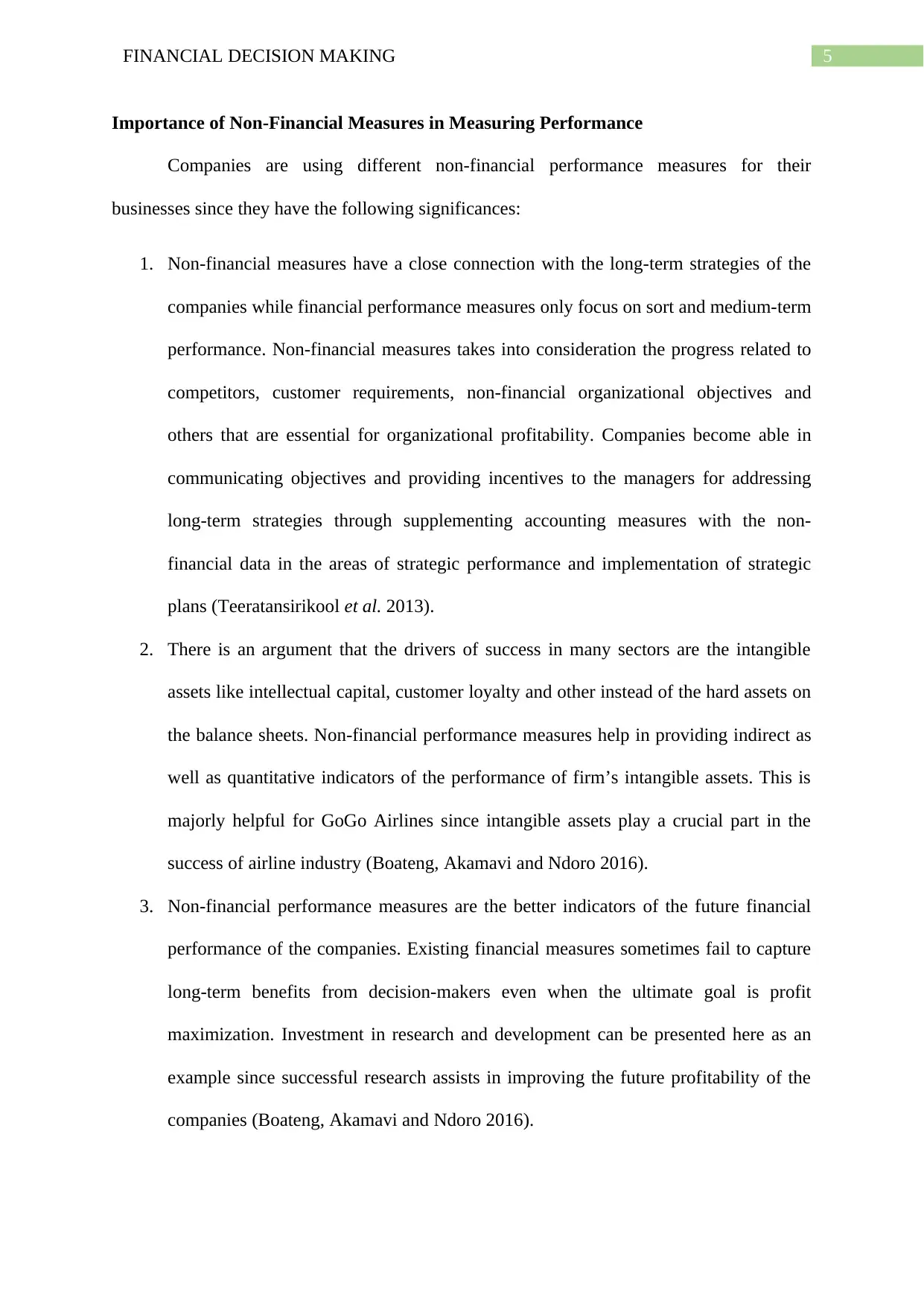
5FINANCIAL DECISION MAKING
Importance of Non-Financial Measures in Measuring Performance
Companies are using different non-financial performance measures for their
businesses since they have the following significances:
1. Non-financial measures have a close connection with the long-term strategies of the
companies while financial performance measures only focus on sort and medium-term
performance. Non-financial measures takes into consideration the progress related to
competitors, customer requirements, non-financial organizational objectives and
others that are essential for organizational profitability. Companies become able in
communicating objectives and providing incentives to the managers for addressing
long-term strategies through supplementing accounting measures with the non-
financial data in the areas of strategic performance and implementation of strategic
plans (Teeratansirikool et al. 2013).
2. There is an argument that the drivers of success in many sectors are the intangible
assets like intellectual capital, customer loyalty and other instead of the hard assets on
the balance sheets. Non-financial performance measures help in providing indirect as
well as quantitative indicators of the performance of firm’s intangible assets. This is
majorly helpful for GoGo Airlines since intangible assets play a crucial part in the
success of airline industry (Boateng, Akamavi and Ndoro 2016).
3. Non-financial performance measures are the better indicators of the future financial
performance of the companies. Existing financial measures sometimes fail to capture
long-term benefits from decision-makers even when the ultimate goal is profit
maximization. Investment in research and development can be presented here as an
example since successful research assists in improving the future profitability of the
companies (Boateng, Akamavi and Ndoro 2016).
Importance of Non-Financial Measures in Measuring Performance
Companies are using different non-financial performance measures for their
businesses since they have the following significances:
1. Non-financial measures have a close connection with the long-term strategies of the
companies while financial performance measures only focus on sort and medium-term
performance. Non-financial measures takes into consideration the progress related to
competitors, customer requirements, non-financial organizational objectives and
others that are essential for organizational profitability. Companies become able in
communicating objectives and providing incentives to the managers for addressing
long-term strategies through supplementing accounting measures with the non-
financial data in the areas of strategic performance and implementation of strategic
plans (Teeratansirikool et al. 2013).
2. There is an argument that the drivers of success in many sectors are the intangible
assets like intellectual capital, customer loyalty and other instead of the hard assets on
the balance sheets. Non-financial performance measures help in providing indirect as
well as quantitative indicators of the performance of firm’s intangible assets. This is
majorly helpful for GoGo Airlines since intangible assets play a crucial part in the
success of airline industry (Boateng, Akamavi and Ndoro 2016).
3. Non-financial performance measures are the better indicators of the future financial
performance of the companies. Existing financial measures sometimes fail to capture
long-term benefits from decision-makers even when the ultimate goal is profit
maximization. Investment in research and development can be presented here as an
example since successful research assists in improving the future profitability of the
companies (Boateng, Akamavi and Ndoro 2016).
⊘ This is a preview!⊘
Do you want full access?
Subscribe today to unlock all pages.

Trusted by 1+ million students worldwide
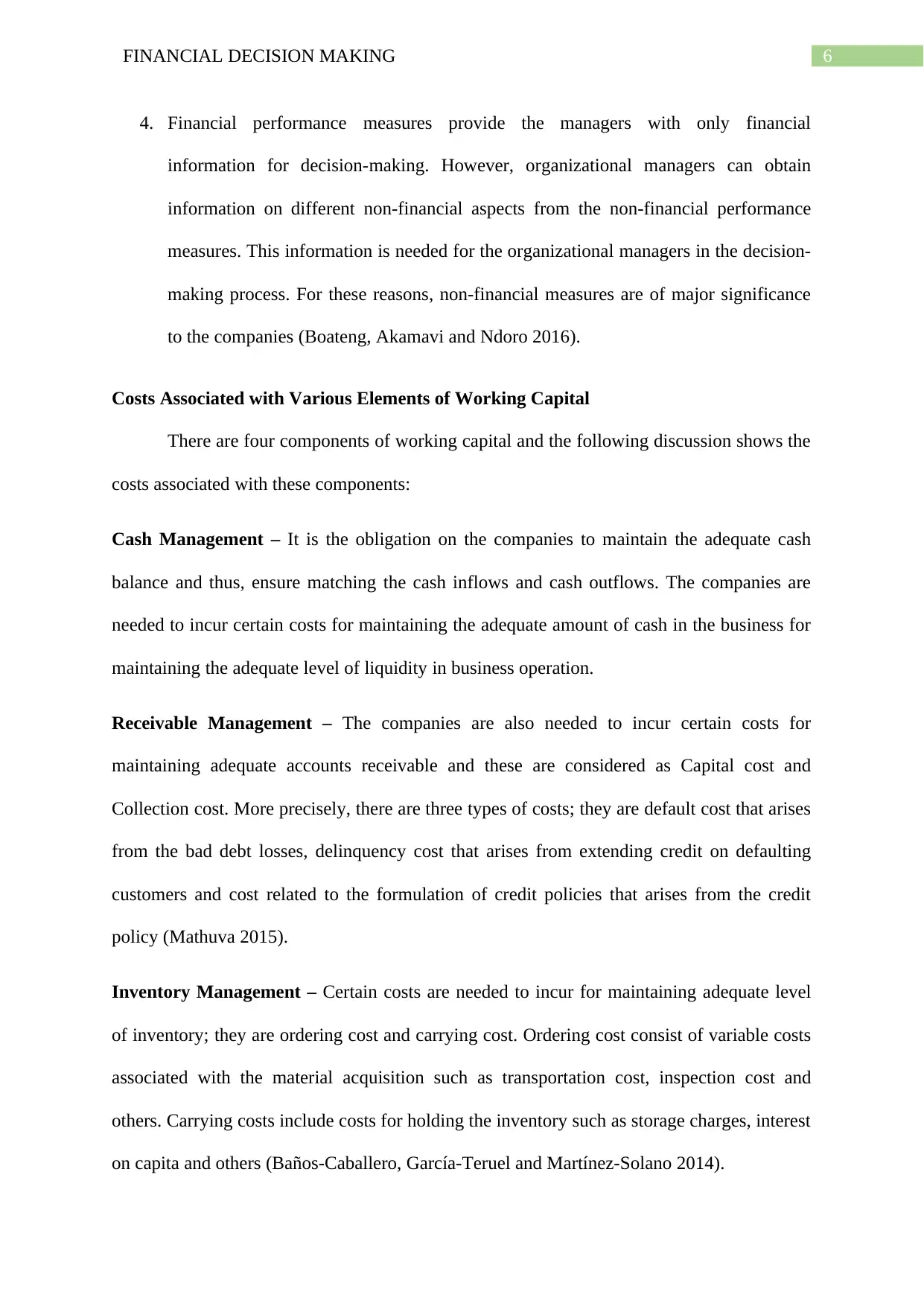
6FINANCIAL DECISION MAKING
4. Financial performance measures provide the managers with only financial
information for decision-making. However, organizational managers can obtain
information on different non-financial aspects from the non-financial performance
measures. This information is needed for the organizational managers in the decision-
making process. For these reasons, non-financial measures are of major significance
to the companies (Boateng, Akamavi and Ndoro 2016).
Costs Associated with Various Elements of Working Capital
There are four components of working capital and the following discussion shows the
costs associated with these components:
Cash Management – It is the obligation on the companies to maintain the adequate cash
balance and thus, ensure matching the cash inflows and cash outflows. The companies are
needed to incur certain costs for maintaining the adequate amount of cash in the business for
maintaining the adequate level of liquidity in business operation.
Receivable Management – The companies are also needed to incur certain costs for
maintaining adequate accounts receivable and these are considered as Capital cost and
Collection cost. More precisely, there are three types of costs; they are default cost that arises
from the bad debt losses, delinquency cost that arises from extending credit on defaulting
customers and cost related to the formulation of credit policies that arises from the credit
policy (Mathuva 2015).
Inventory Management – Certain costs are needed to incur for maintaining adequate level
of inventory; they are ordering cost and carrying cost. Ordering cost consist of variable costs
associated with the material acquisition such as transportation cost, inspection cost and
others. Carrying costs include costs for holding the inventory such as storage charges, interest
on capita and others (Baños-Caballero, García-Teruel and Martínez-Solano 2014).
4. Financial performance measures provide the managers with only financial
information for decision-making. However, organizational managers can obtain
information on different non-financial aspects from the non-financial performance
measures. This information is needed for the organizational managers in the decision-
making process. For these reasons, non-financial measures are of major significance
to the companies (Boateng, Akamavi and Ndoro 2016).
Costs Associated with Various Elements of Working Capital
There are four components of working capital and the following discussion shows the
costs associated with these components:
Cash Management – It is the obligation on the companies to maintain the adequate cash
balance and thus, ensure matching the cash inflows and cash outflows. The companies are
needed to incur certain costs for maintaining the adequate amount of cash in the business for
maintaining the adequate level of liquidity in business operation.
Receivable Management – The companies are also needed to incur certain costs for
maintaining adequate accounts receivable and these are considered as Capital cost and
Collection cost. More precisely, there are three types of costs; they are default cost that arises
from the bad debt losses, delinquency cost that arises from extending credit on defaulting
customers and cost related to the formulation of credit policies that arises from the credit
policy (Mathuva 2015).
Inventory Management – Certain costs are needed to incur for maintaining adequate level
of inventory; they are ordering cost and carrying cost. Ordering cost consist of variable costs
associated with the material acquisition such as transportation cost, inspection cost and
others. Carrying costs include costs for holding the inventory such as storage charges, interest
on capita and others (Baños-Caballero, García-Teruel and Martínez-Solano 2014).
Paraphrase This Document
Need a fresh take? Get an instant paraphrase of this document with our AI Paraphraser
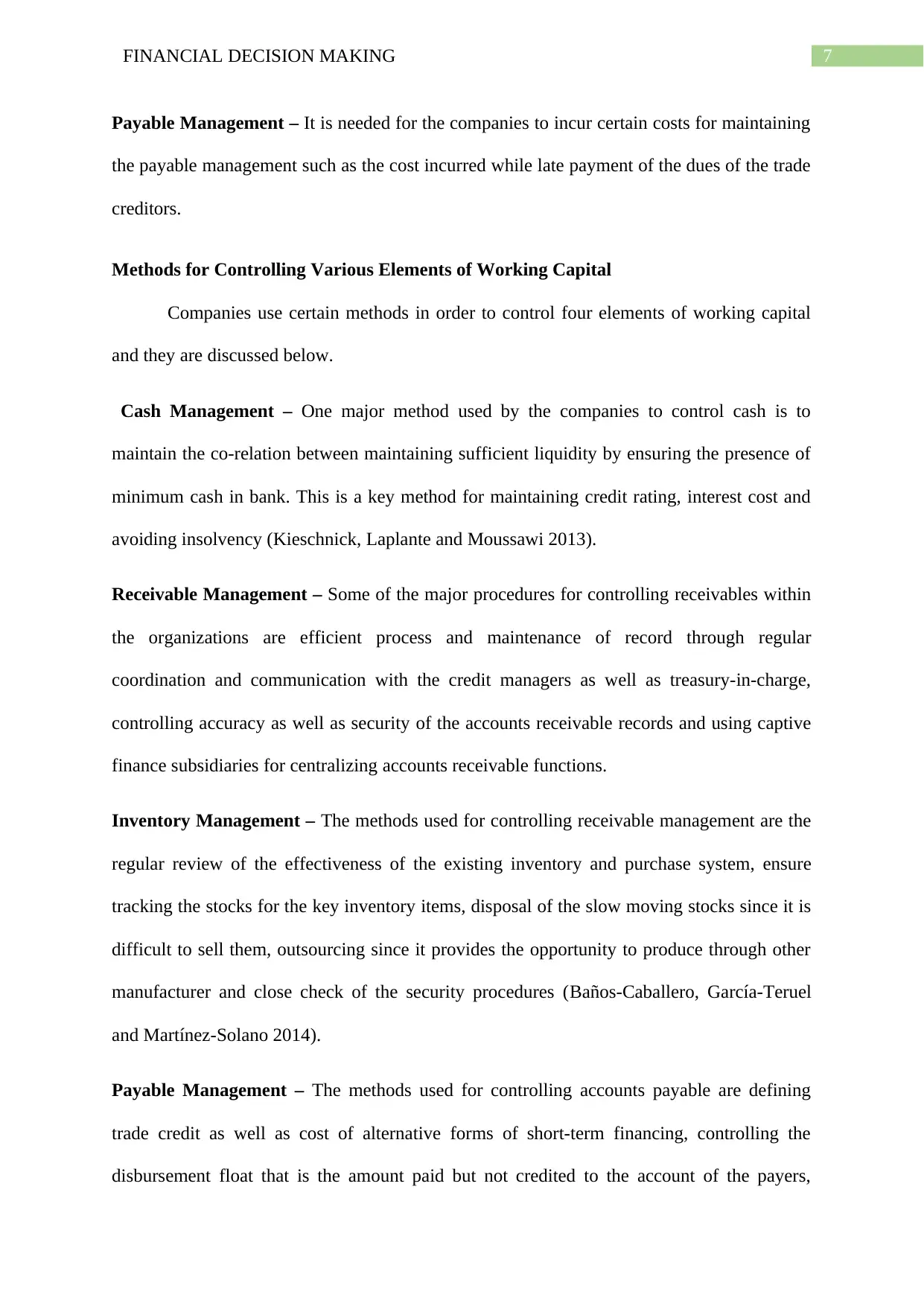
7FINANCIAL DECISION MAKING
Payable Management – It is needed for the companies to incur certain costs for maintaining
the payable management such as the cost incurred while late payment of the dues of the trade
creditors.
Methods for Controlling Various Elements of Working Capital
Companies use certain methods in order to control four elements of working capital
and they are discussed below.
Cash Management – One major method used by the companies to control cash is to
maintain the co-relation between maintaining sufficient liquidity by ensuring the presence of
minimum cash in bank. This is a key method for maintaining credit rating, interest cost and
avoiding insolvency (Kieschnick, Laplante and Moussawi 2013).
Receivable Management – Some of the major procedures for controlling receivables within
the organizations are efficient process and maintenance of record through regular
coordination and communication with the credit managers as well as treasury-in-charge,
controlling accuracy as well as security of the accounts receivable records and using captive
finance subsidiaries for centralizing accounts receivable functions.
Inventory Management – The methods used for controlling receivable management are the
regular review of the effectiveness of the existing inventory and purchase system, ensure
tracking the stocks for the key inventory items, disposal of the slow moving stocks since it is
difficult to sell them, outsourcing since it provides the opportunity to produce through other
manufacturer and close check of the security procedures (Baños-Caballero, García-Teruel
and Martínez-Solano 2014).
Payable Management – The methods used for controlling accounts payable are defining
trade credit as well as cost of alternative forms of short-term financing, controlling the
disbursement float that is the amount paid but not credited to the account of the payers,
Payable Management – It is needed for the companies to incur certain costs for maintaining
the payable management such as the cost incurred while late payment of the dues of the trade
creditors.
Methods for Controlling Various Elements of Working Capital
Companies use certain methods in order to control four elements of working capital
and they are discussed below.
Cash Management – One major method used by the companies to control cash is to
maintain the co-relation between maintaining sufficient liquidity by ensuring the presence of
minimum cash in bank. This is a key method for maintaining credit rating, interest cost and
avoiding insolvency (Kieschnick, Laplante and Moussawi 2013).
Receivable Management – Some of the major procedures for controlling receivables within
the organizations are efficient process and maintenance of record through regular
coordination and communication with the credit managers as well as treasury-in-charge,
controlling accuracy as well as security of the accounts receivable records and using captive
finance subsidiaries for centralizing accounts receivable functions.
Inventory Management – The methods used for controlling receivable management are the
regular review of the effectiveness of the existing inventory and purchase system, ensure
tracking the stocks for the key inventory items, disposal of the slow moving stocks since it is
difficult to sell them, outsourcing since it provides the opportunity to produce through other
manufacturer and close check of the security procedures (Baños-Caballero, García-Teruel
and Martínez-Solano 2014).
Payable Management – The methods used for controlling accounts payable are defining
trade credit as well as cost of alternative forms of short-term financing, controlling the
disbursement float that is the amount paid but not credited to the account of the payers,
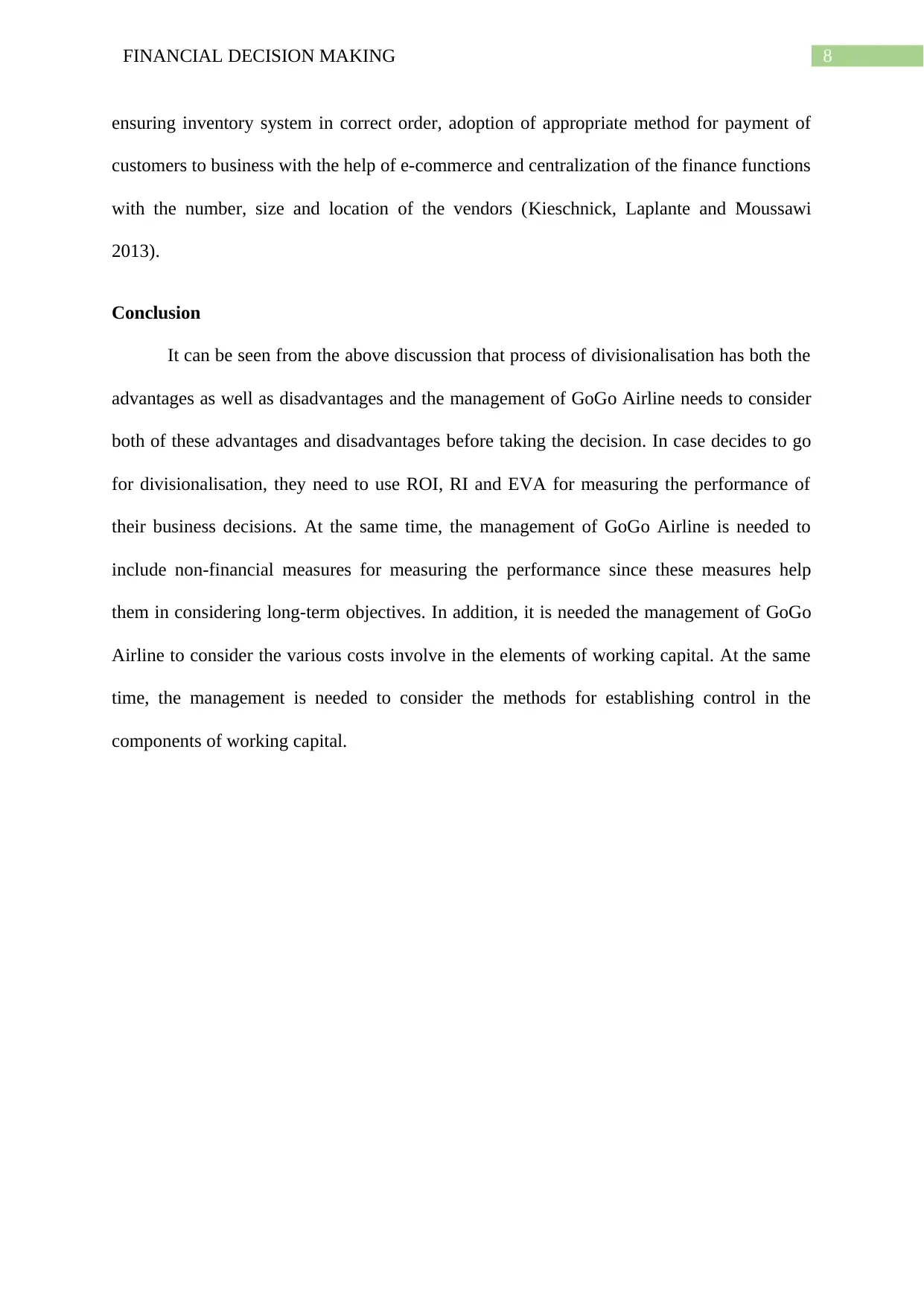
8FINANCIAL DECISION MAKING
ensuring inventory system in correct order, adoption of appropriate method for payment of
customers to business with the help of e-commerce and centralization of the finance functions
with the number, size and location of the vendors (Kieschnick, Laplante and Moussawi
2013).
Conclusion
It can be seen from the above discussion that process of divisionalisation has both the
advantages as well as disadvantages and the management of GoGo Airline needs to consider
both of these advantages and disadvantages before taking the decision. In case decides to go
for divisionalisation, they need to use ROI, RI and EVA for measuring the performance of
their business decisions. At the same time, the management of GoGo Airline is needed to
include non-financial measures for measuring the performance since these measures help
them in considering long-term objectives. In addition, it is needed the management of GoGo
Airline to consider the various costs involve in the elements of working capital. At the same
time, the management is needed to consider the methods for establishing control in the
components of working capital.
ensuring inventory system in correct order, adoption of appropriate method for payment of
customers to business with the help of e-commerce and centralization of the finance functions
with the number, size and location of the vendors (Kieschnick, Laplante and Moussawi
2013).
Conclusion
It can be seen from the above discussion that process of divisionalisation has both the
advantages as well as disadvantages and the management of GoGo Airline needs to consider
both of these advantages and disadvantages before taking the decision. In case decides to go
for divisionalisation, they need to use ROI, RI and EVA for measuring the performance of
their business decisions. At the same time, the management of GoGo Airline is needed to
include non-financial measures for measuring the performance since these measures help
them in considering long-term objectives. In addition, it is needed the management of GoGo
Airline to consider the various costs involve in the elements of working capital. At the same
time, the management is needed to consider the methods for establishing control in the
components of working capital.
⊘ This is a preview!⊘
Do you want full access?
Subscribe today to unlock all pages.

Trusted by 1+ million students worldwide
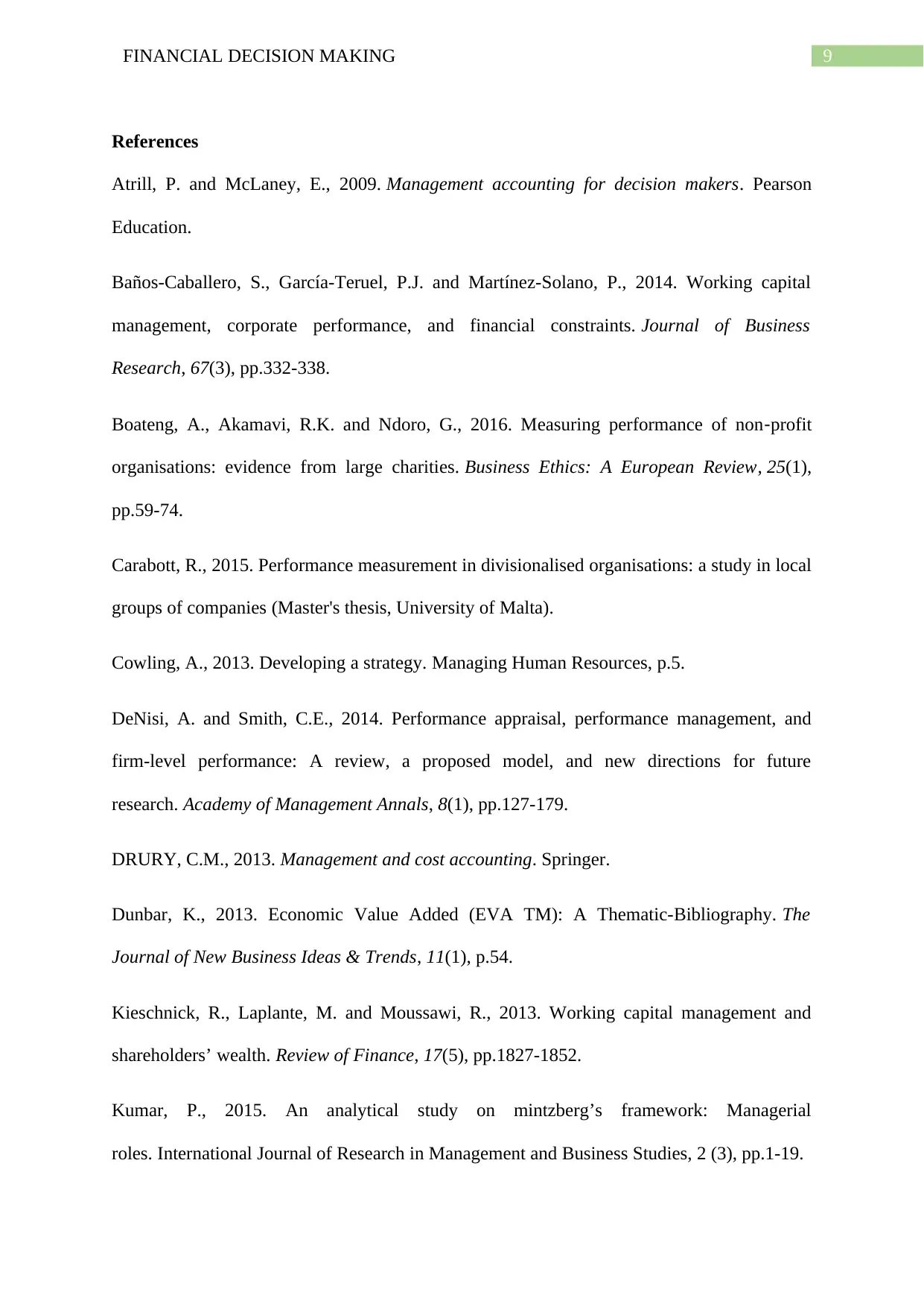
9FINANCIAL DECISION MAKING
References
Atrill, P. and McLaney, E., 2009. Management accounting for decision makers. Pearson
Education.
Baños-Caballero, S., García-Teruel, P.J. and Martínez-Solano, P., 2014. Working capital
management, corporate performance, and financial constraints. Journal of Business
Research, 67(3), pp.332-338.
Boateng, A., Akamavi, R.K. and Ndoro, G., 2016. Measuring performance of non‐profit
organisations: evidence from large charities. Business Ethics: A European Review, 25(1),
pp.59-74.
Carabott, R., 2015. Performance measurement in divisionalised organisations: a study in local
groups of companies (Master's thesis, University of Malta).
Cowling, A., 2013. Developing a strategy. Managing Human Resources, p.5.
DeNisi, A. and Smith, C.E., 2014. Performance appraisal, performance management, and
firm-level performance: A review, a proposed model, and new directions for future
research. Academy of Management Annals, 8(1), pp.127-179.
DRURY, C.M., 2013. Management and cost accounting. Springer.
Dunbar, K., 2013. Economic Value Added (EVA TM): A Thematic-Bibliography. The
Journal of New Business Ideas & Trends, 11(1), p.54.
Kieschnick, R., Laplante, M. and Moussawi, R., 2013. Working capital management and
shareholders’ wealth. Review of Finance, 17(5), pp.1827-1852.
Kumar, P., 2015. An analytical study on mintzberg’s framework: Managerial
roles. International Journal of Research in Management and Business Studies, 2 (3), pp.1-19.
References
Atrill, P. and McLaney, E., 2009. Management accounting for decision makers. Pearson
Education.
Baños-Caballero, S., García-Teruel, P.J. and Martínez-Solano, P., 2014. Working capital
management, corporate performance, and financial constraints. Journal of Business
Research, 67(3), pp.332-338.
Boateng, A., Akamavi, R.K. and Ndoro, G., 2016. Measuring performance of non‐profit
organisations: evidence from large charities. Business Ethics: A European Review, 25(1),
pp.59-74.
Carabott, R., 2015. Performance measurement in divisionalised organisations: a study in local
groups of companies (Master's thesis, University of Malta).
Cowling, A., 2013. Developing a strategy. Managing Human Resources, p.5.
DeNisi, A. and Smith, C.E., 2014. Performance appraisal, performance management, and
firm-level performance: A review, a proposed model, and new directions for future
research. Academy of Management Annals, 8(1), pp.127-179.
DRURY, C.M., 2013. Management and cost accounting. Springer.
Dunbar, K., 2013. Economic Value Added (EVA TM): A Thematic-Bibliography. The
Journal of New Business Ideas & Trends, 11(1), p.54.
Kieschnick, R., Laplante, M. and Moussawi, R., 2013. Working capital management and
shareholders’ wealth. Review of Finance, 17(5), pp.1827-1852.
Kumar, P., 2015. An analytical study on mintzberg’s framework: Managerial
roles. International Journal of Research in Management and Business Studies, 2 (3), pp.1-19.
Paraphrase This Document
Need a fresh take? Get an instant paraphrase of this document with our AI Paraphraser

10FINANCIAL DECISION MAKING
Mathuva, D., 2015. The Influence of working capital management components on corporate
profitability.
McNulty, Y., De Cieri, H. and Hutchings, K., 2013. Expatriate return on investment in the
Asia Pacific: An empirical study of individual ROI versus corporate ROI. Journal of World
Business, 48(2), pp.209-221.
Sloof, R. and Van Praag, M., 2015. Testing for Distortions in Performance Measures: An
Application to Residual Income‐Based Measures like Economic Value Added. Journal of
Economics & Management Strategy, 24(1), pp.74-91.
Teeratansirikool, L., Siengthai, S., Badir, Y. and Charoenngam, C., 2013. Competitive
strategies and firm performance: the mediating role of performance
measurement. International Journal of Productivity and Performance Management, 62(2),
pp.168-184.
Mathuva, D., 2015. The Influence of working capital management components on corporate
profitability.
McNulty, Y., De Cieri, H. and Hutchings, K., 2013. Expatriate return on investment in the
Asia Pacific: An empirical study of individual ROI versus corporate ROI. Journal of World
Business, 48(2), pp.209-221.
Sloof, R. and Van Praag, M., 2015. Testing for Distortions in Performance Measures: An
Application to Residual Income‐Based Measures like Economic Value Added. Journal of
Economics & Management Strategy, 24(1), pp.74-91.
Teeratansirikool, L., Siengthai, S., Badir, Y. and Charoenngam, C., 2013. Competitive
strategies and firm performance: the mediating role of performance
measurement. International Journal of Productivity and Performance Management, 62(2),
pp.168-184.
1 out of 11
Related Documents
Your All-in-One AI-Powered Toolkit for Academic Success.
+13062052269
info@desklib.com
Available 24*7 on WhatsApp / Email
![[object Object]](/_next/static/media/star-bottom.7253800d.svg)
Unlock your academic potential
Copyright © 2020–2025 A2Z Services. All Rights Reserved. Developed and managed by ZUCOL.




